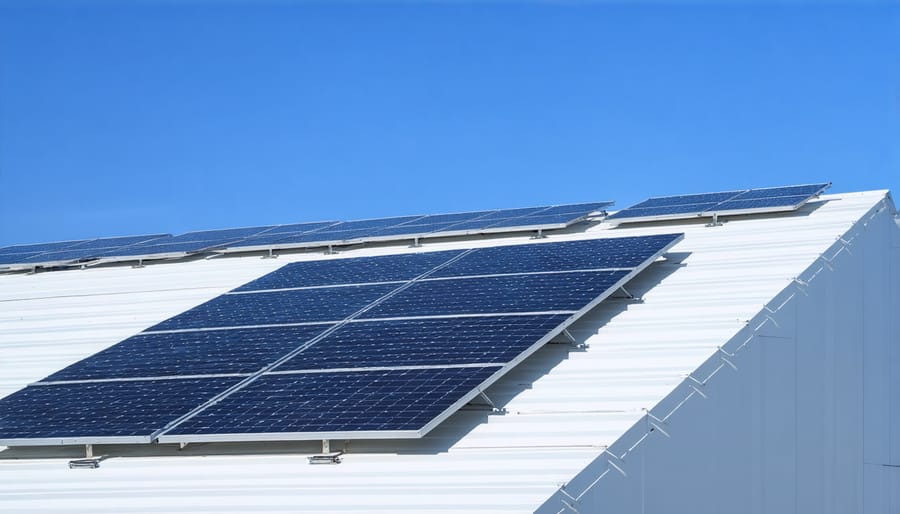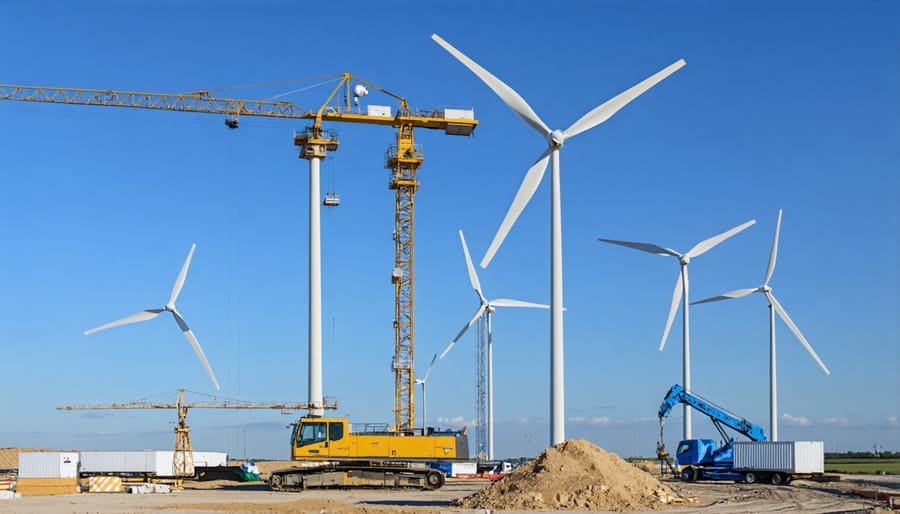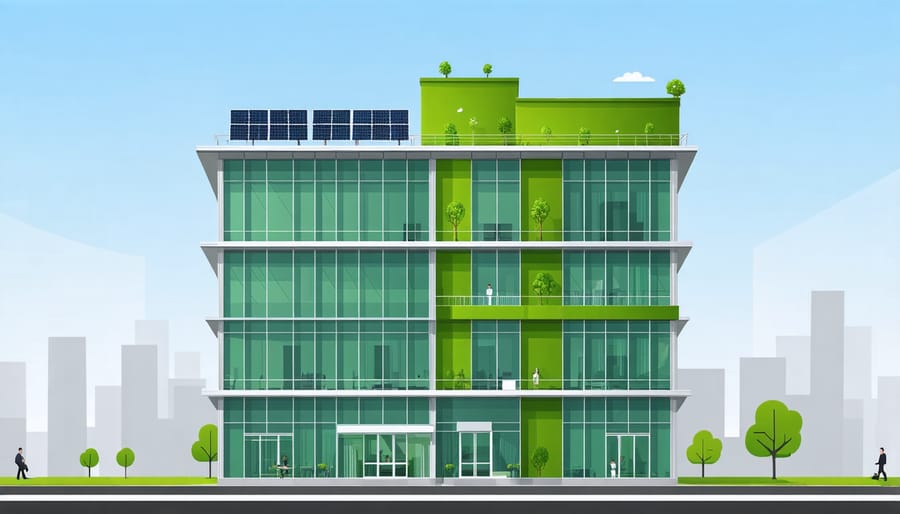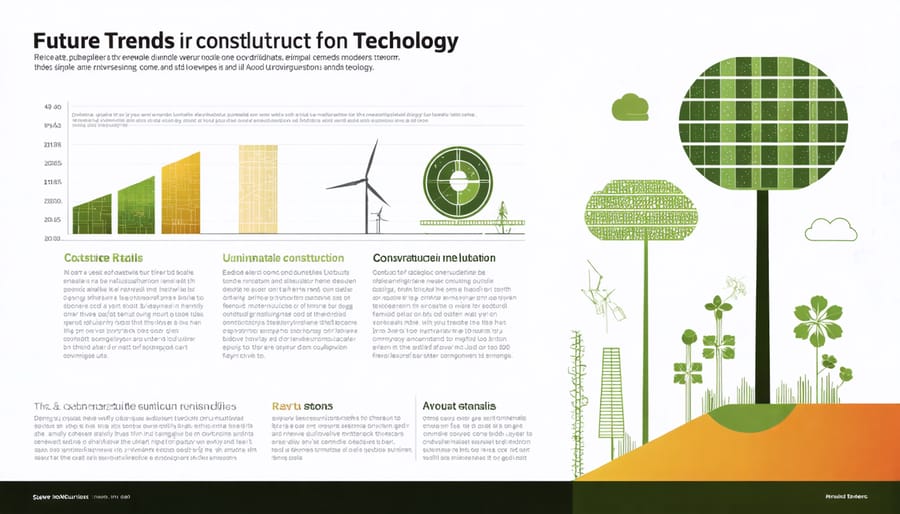Renewable energy construction companies stand at the forefront of the energy transition in construction, transforming how we build and power our infrastructure. In 2023, these specialized contractors generated over $50 billion in revenue while deploying innovative solutions across solar, wind, and energy storage projects worldwide. Their expertise spans from utility-scale installations to integrated building systems, combining traditional construction knowledge with cutting-edge renewable technologies.
As global investment in clean energy infrastructure reaches unprecedented levels, these companies are revolutionizing project delivery methods, safety protocols, and sustainability standards. They leverage advanced modeling software, drone technology, and artificial intelligence to optimize installation efficiency while reducing environmental impact. Their work extends beyond mere construction to include grid integration, performance monitoring, and long-term maintenance solutions.
Leading firms in this sector demonstrate exceptional capabilities in managing complex supply chains, navigating regulatory frameworks, and coordinating multi-stakeholder projects. Their success hinges on precise engineering, robust quality control systems, and deep understanding of both construction methodologies and renewable energy technologies. This specialized expertise positions them as critical players in achieving international climate goals and reshaping the built environment for generations to come.
The Evolution of Green Construction Companies
Market Drivers and Industry Trends
The renewable energy construction sector is experiencing unprecedented growth, driven by several key market forces and evolving industry trends. Government incentives and regulations, particularly tax credits and renewable portfolio standards, continue to stimulate market expansion. The Inflation Reduction Act of 2022 has notably accelerated project development by providing substantial financial incentives for renewable energy installations.
Cost reduction in solar and wind technologies has emerged as a primary market driver, with equipment prices dropping by over 70% in the past decade. This decrease has made renewable energy projects increasingly competitive with traditional power sources, attracting both private and institutional investors.
Corporate sustainability commitments are also fueling demand, as major companies pledge to achieve net-zero emissions and source renewable power. This has led to a surge in power purchase agreements and on-site generation projects.
Technological advancements in energy storage solutions and smart grid integration are creating new opportunities for construction companies. The industry is witnessing increased demand for hybrid projects that combine multiple renewable sources with storage capabilities, requiring specialized construction expertise.
Urbanization and sustainable building regulations are further driving the integration of renewable energy systems into new construction projects, particularly in commercial and residential developments.
Regulatory Framework and Certifications
Renewable energy construction companies must navigate a complex landscape of regulations and certifications to ensure compliance and demonstrate expertise. At the federal level, companies must adhere to standards set by the Environmental Protection Agency (EPA) and Department of Energy (DOE), particularly regarding emissions control and energy efficiency benchmarks.
Key certifications include LEED (Leadership in Energy and Environmental Design), which validates sustainable construction practices, and NABCEP (North American Board of Certified Energy Practitioners) for solar installations. The International Organization for Standardization’s ISO 50001 certification focuses on energy management systems, while ISO 14001 addresses environmental management standards.
State-specific requirements vary significantly, with some jurisdictions mandating specialized renewable energy contractor licenses. Companies must also comply with local building codes, zoning laws, and electrical regulations. Professional certifications from organizations like the Association of Energy Engineers (AEE) and Building Performance Institute (BPI) further demonstrate technical competency.
Regular audits and documentation of compliance are essential, as regulations evolve with technological advances and environmental policies. Companies must maintain updated certifications and stay informed about changing requirements to remain competitive and compliant.
Innovative Technologies in Renewable Construction
Solar Integration Solutions
Modern solar construction has evolved significantly, incorporating advanced solar integration technologies that maximize energy harvest while maintaining structural integrity. Leading contractors now employ building-integrated photovoltaics (BIPV) that seamlessly incorporate solar cells into building materials, including roof tiles, facades, and windows.
Recent innovations in mounting systems have revolutionized installation efficiency, with rail-less solutions reducing material costs by up to 20% while cutting installation time by 30%. Advanced microinverter systems enable module-level power optimization, ensuring maximum performance even when portions of the array are shaded or compromised.
Construction teams are increasingly utilizing precision laser alignment tools and drone mapping technology to optimize panel placement and orientation. These tools, combined with sophisticated modeling software, help achieve optimal energy yields while accounting for site-specific factors such as shadow patterns and structural loads.
Weather-resistant materials and enhanced sealing techniques have significantly improved the durability of solar installations. New-generation solar panels feature self-cleaning hydrophobic coatings and reinforced glass that can withstand severe weather conditions while maintaining peak efficiency. Integration with smart building management systems allows for real-time performance monitoring and automated maintenance scheduling, ensuring sustained energy production throughout the system’s lifecycle.

Wind Energy Infrastructure
Construction of wind energy facilities requires specialized expertise and precise engineering to maximize energy generation efficiency. The process typically begins with extensive site assessment, including wind resource analysis, environmental impact studies, and geotechnical surveys to determine optimal turbine placement.
Foundation construction represents a critical phase, with designs varying based on soil conditions and turbine specifications. Typical foundations require reinforced concrete bases ranging from 15-30 meters in diameter and 2-3 meters deep. For offshore installations, specialized foundation types such as monopiles, gravity-based structures, or floating foundations are employed depending on water depth and seabed conditions.
The assembly process involves heavy-lift cranes capable of hoisting turbine components weighing several hundred tons. Modern wind turbines typically reach heights of 80-120 meters, with rotor diameters extending beyond 100 meters. Construction teams must carefully coordinate the installation of major components, including the tower sections, nacelle, and rotor blades, often under challenging weather conditions.
Infrastructure development extends beyond turbine installation to include access roads capable of supporting heavy equipment, electrical substations, and transmission infrastructure. Underground cable networks connect individual turbines to substations, where voltage is stepped up for grid integration.
Quality control measures during construction focus on structural integrity, proper alignment, and electrical system verification. Advanced monitoring systems are integrated during installation to enable remote performance tracking and predictive maintenance throughout the facility’s operational life.

Energy Storage Systems
Modern renewable energy construction companies increasingly recognize that effective energy storage solutions are crucial for maximizing the potential of renewable power systems. The integration of advanced battery technologies and storage systems enables consistent power delivery, even when renewable sources like solar and wind are intermittent.
Leading construction firms now incorporate lithium-ion battery banks, flow batteries, and thermal storage systems into their renewable energy projects. These storage systems typically range from 50kWh for small commercial installations to several MWh for large-scale industrial applications. The selection of appropriate storage capacity depends on factors including peak demand, load profiles, and backup power requirements.
Recent technological advances have significantly improved storage efficiency and reduced costs, with prices dropping by approximately 85% over the past decade. Construction companies are implementing sophisticated battery management systems (BMS) that optimize charging cycles, monitor performance metrics, and ensure safe operation. These systems integrate seamlessly with building management systems (BMS) to provide real-time data and automated control.
Industry leaders are also exploring innovative storage alternatives, such as hydrogen fuel cells and compressed air energy storage (CAES). These emerging technologies offer promising solutions for long-duration storage needs, particularly in projects requiring extended backup power capabilities or grid independence.
Case Studies: Success Stories in Action

Commercial Development Projects
Commercial renewable energy projects have significantly evolved, with construction companies now handling increasingly complex and large-scale implementations. Leading firms like Mortenson Construction and AECOM have demonstrated exceptional capabilities in developing utility-scale solar farms, wind energy facilities, and hybrid renewable installations across multiple continents.
Recent notable developments include the 500MW Sunshine Valley Solar Project in Nevada, which incorporated advanced tracking systems and required specialized construction techniques for desert conditions. Similarly, the 1.5GW Gemini Solar Project showcases how construction companies are adapting to handle mega-scale installations while maintaining strict environmental protection protocols.
Construction methodologies for commercial projects have become increasingly sophisticated, with companies employing drone technology for site surveys, AI-powered project management systems, and automated installation equipment. These innovations have reduced construction timelines by up to 30% while improving safety metrics and quality control.
Key considerations in commercial development include:
– Grid integration infrastructure
– Environmental impact assessments
– Local workforce development
– Supply chain optimization
– Performance guarantee structures
– Maintenance accessibility design
Industry leaders report that successful commercial projects now require integrated expertise in civil engineering, electrical systems, and environmental management. The construction process typically involves multiple phases, from initial site preparation and foundation work to final commissioning and grid connection.
Financial institutions have shown increased confidence in large-scale renewable projects, with construction companies often participating in innovative funding structures. This has led to the development of more ambitious projects, including floating solar installations and hybrid wind-solar facilities.
Construction companies are also implementing modular construction techniques for faster deployment and standardized quality control. This approach has proven particularly effective in remote locations where traditional construction methods face logistical challenges.
The success of these commercial projects has established new benchmarks for the industry, with construction companies continually refining their methodologies to achieve greater efficiency and reliability in renewable energy infrastructure development.
Residential Success Stories
The residential sector has witnessed remarkable success stories in renewable energy construction, demonstrating the practical benefits of sustainable building practices. In Sacramento, California, the Oak Grove development showcases how a planned community of 85 homes achieved net-zero energy consumption through strategic solar panel installation and advanced building envelope design. Each residence generates an average of 7,500 kWh annually, resulting in substantial energy cost savings for homeowners.
Another noteworthy example comes from Austin, Texas, where the Mueller Sustainable Community transformed a former airport site into an energy-efficient residential haven. The project features 280 homes equipped with geothermal heating systems and solar arrays, reducing energy consumption by 65% compared to conventional homes. The community’s success has made it a model for sustainable residential development across the Southwest.
In the Northeast, the Vermont Green Home Alliance completed a pioneering project in Burlington, incorporating both passive solar design and active renewable systems. The development of 12 single-family homes utilizes triple-pane windows, superior insulation, and roof-mounted solar panels, achieving complete energy independence during summer months.
Small-scale success stories are equally impressive. In Portland, Oregon, a renovation project by Green Future Builders transformed a 1950s bungalow into a modern, energy-producing home. The retrofit included a 6.2 kW solar system, ground-source heat pump, and smart energy management systems, resulting in a 95% reduction in energy costs.
These examples demonstrate how renewable energy construction companies are revolutionizing residential building practices. Key success factors include comprehensive planning, integration of multiple renewable technologies, and attention to building envelope efficiency. The projects not only showcase technical achievement but also prove the economic viability of renewable energy solutions in residential construction, with most homeowners reporting investment recovery periods of 7-10 years through energy savings.
Future Prospects and Industry Challenges

Emerging Technologies and Opportunities
The renewable energy construction sector is experiencing rapid technological advancement, creating new opportunities for innovation and growth. Smart building technologies are transforming how we approach energy management, with integrated systems that optimize power consumption and distribution in real-time.
Advanced energy storage solutions, particularly grid-scale batteries and thermal storage systems, are becoming increasingly viable for construction projects. These technologies enable better management of intermittent renewable sources like solar and wind power, creating more reliable and efficient energy systems for commercial and residential buildings.
Building-integrated photovoltaics (BIPV) represent another significant advancement, incorporating solar-generating materials directly into building elements such as windows, facades, and roofing materials. This integration reduces installation costs while maintaining architectural aesthetics, making renewable energy more attractive to developers and property owners.
Emerging opportunities also exist in microgrids and distributed energy systems, which allow buildings to operate independently or in conjunction with the main power grid. Construction companies are increasingly incorporating these systems into their projects, particularly for commercial and industrial facilities requiring reliable power supply.
Artificial intelligence and machine learning applications are revolutionizing project planning and energy system optimization. These technologies enable precise forecasting of energy needs, automated adjustment of building systems, and predictive maintenance of renewable energy installations, significantly improving operational efficiency and reducing costs. The integration of these advanced technologies presents substantial growth opportunities for construction companies willing to invest in expertise and capabilities in these areas.
Overcoming Implementation Barriers
Successfully implementing renewable energy construction projects requires strategic approaches to overcome common industry barriers. Financial constraints often pose the first significant challenge, but companies are increasingly leveraging innovative funding models, including power purchase agreements (PPAs), green bonds, and government incentives to offset initial costs.
Technical complexity presents another hurdle, particularly when integrating renewable systems with existing infrastructure. Leading firms address this by investing in comprehensive training programs for their workforce and establishing partnerships with specialized technology providers. This approach ensures teams are well-equipped to handle advanced renewable installations while meeting zero-energy building standards.
Supply chain disruptions and material availability can impact project timelines significantly. Successful companies maintain relationships with multiple suppliers and implement robust inventory management systems to mitigate these risks. They also incorporate contingency planning into their project schedules to account for potential delays.
Regulatory compliance and permitting processes often create bottlenecks. Forward-thinking construction companies address this by developing dedicated compliance teams and maintaining strong relationships with local authorities. They also participate in industry associations to stay informed about upcoming regulatory changes and contribute to policy discussions.
Public perception and stakeholder buy-in remain crucial factors. Companies overcome these challenges through transparent communication strategies, community engagement programs, and detailed documentation of environmental benefits. By demonstrating clear ROI and environmental impact metrics, they successfully convince stakeholders of the long-term value of renewable energy investments.
The renewable energy construction sector stands at a pivotal moment, with unprecedented growth opportunities and technological advancements shaping its future. As we’ve explored throughout this article, these specialized construction companies have evolved from niche players to major industry forces, driven by increasing environmental awareness, favorable policies, and improving cost economics.
The success of renewable energy construction firms increasingly depends on their ability to adapt to rapid technological changes, maintain high safety standards, and deliver projects efficiently. Companies that invest in workforce development, embrace digital technologies, and maintain strong supplier relationships are better positioned to capitalize on the growing demand for renewable energy infrastructure.
Market projections indicate substantial growth in the coming decade, with wind and solar installations expected to dominate new energy capacity additions globally. This trend is further supported by ambitious climate goals set by governments and corporations, creating a robust pipeline of projects for specialized construction firms.
However, challenges remain. Supply chain constraints, skilled labor shortages, and regulatory uncertainties require careful navigation. Successful companies will need to develop resilient business models that can weather these challenges while maintaining competitive advantages.
Looking ahead, we can expect to see increased consolidation in the sector, with larger construction firms expanding their renewable energy capabilities through acquisitions and strategic partnerships. Innovation in construction methods, including modular construction and automated installation techniques, will likely reshape project execution approaches.
For industry professionals and stakeholders, staying informed about these developments and maintaining flexibility in business strategies will be crucial. The renewable energy construction sector’s future appears promising, with those companies that can balance technical expertise, operational efficiency, and sustainable practices best positioned to thrive in this dynamic market.

